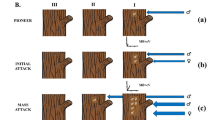Abstract
Attractive compounds affecting the mass aggregation of bark beetle populations on host trees suitable for colonization usually consist of two obligatory components that act synergistically and species-specifically. Semiochemicals inhibiting response act on their own and seem less specific. From nearly 100 species investigated so far, mass aggregation can be simulated with commercial synthetics in about nine species of economic importance. Aspects leading to the application of attractants in monitoring and mass trapping pest populations affecting European spruce forests result from intensive coordinated research at the university, industry, and forestry level. Technology transfer was facilitated by, and adapted to, the infrastructure of European forestry; traps economically replace the trap tree methods conventionally used for centuries. Expected applications in the near future are refined monitoring methods to measure population levels and predict damages. Also, mass trapping should remain a worthwhile tool in preventing beetle damage in forests under management intensive enough to remove excessive breeding material. In the long run, response-inhibiting semiochemicals resulting in the dispersal of pest populations (Ablenkstoffe) may gain wider application. The spruce engraverIps typographus L. and its associatePityogenes chalcographus L. are used as examples to describe the feasibility of developing and applying inhibitors as new tools in the management of bark beetle pests: Applying a slow-release verbenone formulation (verbenone strip) wrapped around the trunk of spruce trees at breast height appears to protect spruces from destructive attack byIps typographus, while small polyethylene ampullae containing terpinene-4-ol counteract aggregation of P. chalcographus. Inhibitors appear applicable in both strategies, damage prevention as well as damage restriction, and consequently may accommodate also pest control in less intensively managed forests. Future application of semiochemicals in the management of bark beetle pests will rest with the availability of effective means and methods and their acceptance by the forestry interest. This acceptance is presently somewhat hampered by misconceptions about mass trapping, and by (1) “missing links” in the knowledge of the beetles′ dispersal and aggregation behavior, (2) the chemosynthesis of chiral pheromone components at the industrial level, and (3) legal barriers.
Similar content being viewed by others
References
Austara, O., Bakke, A., andMitgaard, F. 1986. Response inIps typographus to logging waste odours and synthetic pheromones. Z.Angew. Entomol. 101:194–198.
Baader, E., andVite, J.P. 1986. Zum Einsatz synthetischer Lockstoffe gegen den Kupferstecher.Allg. Forstz. 41:1008.
Bakke, A. 1981. Inhibition of the response inIps typographus to the aggregation pheromone; field evaluation of verbenone and ipsenol. Z.Angew. Entomol. 92:172–177.
Bakke, A. 1987. Repression ofIps typographus infestations in stored logs by semiochemicals.Scand. J. For. Res. 2:179–185.
Bakke, A., andLie, R. 1989. Mass Trapping, pp. 67–87,in A.R. Jutsum and R.F.S. Gordon (eds.). Insect Pheromones in Plant Protection. John Wiley & Sons, Chichester.
Birch, M.C., Light, D.M., andMori, K. 1977. Selective inhibition of response ofIps pint to its pheromone by the (S)-(−)-enantiomer of ipsenol.Nature 270:738–739.
Francke, W., Heemann, V., Gerken, B., Renwick, J.A.A., andVité, J.P. 1977. 2-Ethyl-1, 6-dioxaspiro-(4,4)-nonane, principal aggregation pheromone of Pityogenes chalcographus.Naturwissenschaften 64:590–591.
Francke, W., Sauerwein, P., Vité, J.P., andKlimetzek, D. 1980. The pheromone bouquet ofIps amitinus.Naturwissenschaften 67:147.
Harring, C.M. 1978. Aggregation pheromones of the European fir engraver beetlesPityokteines curvidens, P. spinidens andP. vorontzovi and the role of juvenile hormone in pheromone biosynthesis.Z. Angew. Entomol. 85:281–317.
Kinzer, G.W., Fentiman, A.F., Jr., Foltz, R.L., andRudinsky, J.A. 1971. Bark beetle attractants: 3-methyl-2-cyclohexen-1-one isolated fromDendroctonus pseudotsugae.J. Econ. Entomol. 64:970–971.
König, E., Vité, J.P., andBogenschütz, H. 1981. Überwachung und Bekämpfung vonIps typographus andTrypodendron lineatum (Coleoptera: Scolytidae) mit synthetischen Lockstoffen in Kunstfallen.Mitt. Dtsch. Ges.Allg. Angew. Entomol. 2:326–332.
Kohnle, U. 1984. Beziehung zwischen der Austrocknung von Fangbäumen und ihrer Attraktivität für Fichtenborkenkäfer.Allg. Forst.-Jagdztg. 155:270–275.
Kohnle, U., Francke, W., andBakke, A. 1985.Polygraphus poligraphus: Response to enantiomers of beetle specific terpene alcohols and bicyclic ketal.Z. Angew. Entomol. 100:5–8.
Payne, T.L., andBillings, R.F. 1989. Evaluation of (−)-verbenone applications for suppressing southern pine beetle (Coleoptera: Scolytidae) infestations.Econ. Entomol. 82:1702–1708.
Punja, N. 1989. The registration of pheromones, pp. 295–302,in A.R. Jutsum and R.F.S. Gordon (eds.) Insect Pheromones in Plant Protection. John Wiley & Sons, Chichester.
Renwick, J.A.A., andVité, J.P. 1969. Bark beetle attractants: Mechanism of colonization byDendroctonus frontalis.Nature 224:1222–1223.
Schlyter, F., Byers, J.A., andLöfquist, J. 1987. Attraction to pheromone sources of different quantity, quality, and spacing density-regulation mechanisms in bark beetlesIps typographus.J. Chem. Ecol. 13:1503–1523.
Vaupel, O., Dimitri, L., König, E., andBerwig, W. 1986. Zur Optimierung des Falleneinsatzes bei Buchdruckerund gestreiften Nutzholzborkenkäfer.Allg. Forstzeitschr. 41:572–574.
Vité, J.P. 1989. Lock- und Ablenkstoffe im Waldschutz gegen Borkenkäfer.Mitt. Dtsch. Ges. Allg. Angew. Ent. 7:123–131.
Vité, J.P., andPitman, G.B. 1972. 3-methyl-2-cyclohexen-1-ol isolated fromDendroctonus.Naturwissenschaften 59:469.
Vité, J.P., Klimetzek, D., Loskant, G., Hedden, R., andMori, K. 1976. Chirality of insect pheromones: Response inhibition by inactive antipodes.Naturwissenschaften 63:582–583.
Vité, J.P., Ohloff, G., andBillings, R.F. 1978. Pheromonal chirality and integrity of aggregation response in southern species of the bark beetleIps sp.Nature 272:817–818.
Vité, J.P., Billings, R.F., Ware, C.W., andMori, K. 1985. Southern pine beetle: Enhancement or inhibition of aggregation response mediated by enantiomers of endo-brevicomin.Naturwissenschaften 72:99.
Weslien, J., Annila, E., Bakke, A., Bejer, B., Eidmann, H.H., Narostad, K., Nikula, A., andRavn, H.P. 1989. Estimating risks for spruce bark beetle (Ips typographus L.) damage using pheromone baited traps and trees.Scand. J. For. Res. 4:87–89.
Wulf, A. 1987. Wie steht es um den integrierten Pflanzenschutz im Forst?Nachrichtenbl. Dtsch. Pflanzenschutzdienstes (Braunschweig) 39:22–24.
Author information
Authors and Affiliations
Additional information
Suported by a grant of the deutsche Forschngsgemeinschaft.
Rights and permissions
About this article
Cite this article
Vité, J.P., Baader, E. Present and future use of semiochemicals in pest management of bark beetles. J Chem Ecol 16, 3031–3041 (1990). https://doi.org/10.1007/BF00979610
Received:
Accepted:
Issue Date:
DOI: https://doi.org/10.1007/BF00979610




